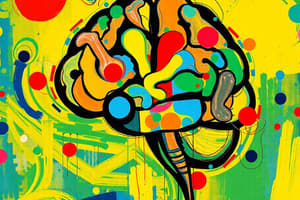Podcast
Questions and Answers
What is alien hand syndrome characterized by?
What is alien hand syndrome characterized by?
- Voluntary movements of the hand
- Involuntary movements of the hand (correct)
- Amputation of the hand
- Paralysis of the hand
Which part of the brain is typically damaged in alien hand syndrome?
Which part of the brain is typically damaged in alien hand syndrome?
- Occipital lobe
- Corpus callosum, anterior commissure, or basal ganglia (correct)
- Frontal lobe
- Cerebellum
What is a common associated condition of alien hand syndrome?
What is a common associated condition of alien hand syndrome?
- Alzheimer's disease (correct)
- Huntington's disease
- Multiple sclerosis
- Parkinson's disease
What is a symptom of alien hand syndrome?
What is a symptom of alien hand syndrome?
How is alien hand syndrome diagnosed?
How is alien hand syndrome diagnosed?
What is a treatment option for alien hand syndrome?
What is a treatment option for alien hand syndrome?
What is the emotional impact of alien hand syndrome?
What is the emotional impact of alien hand syndrome?
What is the prognosis of alien hand syndrome?
What is the prognosis of alien hand syndrome?
Flashcards are hidden until you start studying
Study Notes
Definition and Description
- Alien hand syndrome is a rare neurological disorder characterized by involuntary movements of the hand, often accompanied by a sense of foreignness or disconnection from the affected limb.
- Also known as "alien limb" or "anarchic hand," it can affect either the dominant or non-dominant hand.
Causes and Associated Conditions
- Typically results from damage to the brain, particularly the corpus callosum, anterior commissure, or basal ganglia.
- Often associated with:
- Stroke or traumatic brain injury
- Neurodegenerative diseases (e.g., Alzheimer's, corticobasal degeneration)
- Infections (e.g., encephalitis, meningitis)
- Tumors or cysts in the brain
Symptoms
- Involuntary movements of the hand, which can be:
- Purposeless (e.g., grasping, releasing, or manipulating objects)
- Interfering with voluntary actions
- Coordinated or uncoordinated
- Sensation of foreignness or disconnection from the affected hand
- Difficulty with hand-eye coordination and fine motor tasks
- Possible emotional distress or frustration due to lack of control over the affected hand
Diagnostic Criteria
- Clinical evaluation of symptoms and medical history
- Imaging studies (e.g., MRI, CT scans) to rule out underlying structural abnormalities
- Electrophysiological tests (e.g., EMG, EEG) to assess neural activity
Treatment and Management
- No cure, but various therapies can help manage symptoms:
- Physical therapy to improve hand function and coordination
- Occupational therapy to enhance daily living skills
- Medications (e.g., anticonvulsants, dopamine agonists) to reduce involuntary movements
- Surgical interventions (e.g., corpus callosotomy) in severe cases
Definition and Description
- Alien hand syndrome is a rare neurological disorder characterized by involuntary movements of the hand, often accompanied by a sense of foreignness or disconnection from the affected limb.
- Also known as "alien limb" or "anarchic hand", it can affect either the dominant or non-dominant hand.
Causes and Associated Conditions
- Results from damage to the brain, particularly the corpus callosum, anterior commissure, or basal ganglia.
- Associated with stroke or traumatic brain injury, neurodegenerative diseases (e.g., Alzheimer's, corticobasal degeneration), infections (e.g., encephalitis, meningitis), and tumors or cysts in the brain.
Symptoms
- Involuntary movements of the hand, which can be purposeless, interfere with voluntary actions, and be coordinated or uncoordinated.
- Sensation of foreignness or disconnection from the affected hand.
- Difficulty with hand-eye coordination and fine motor tasks.
- Possible emotional distress or frustration due to lack of control over the affected hand.
Diagnostic Criteria
- Clinical evaluation of symptoms and medical history.
- Imaging studies (e.g., MRI, CT scans) to rule out underlying structural abnormalities.
- Electrophysiological tests (e.g., EMG, EEG) to assess neural activity.
Treatment and Management
- No cure, but various therapies can help manage symptoms.
- Physical therapy to improve hand function and coordination.
- Occupational therapy to enhance daily living skills.
- Medications (e.g., anticonvulsants, dopamine agonists) to reduce involuntary movements.
- Surgical interventions (e.g., corpus callosotomy) in severe cases.
Studying That Suits You
Use AI to generate personalized quizzes and flashcards to suit your learning preferences.




